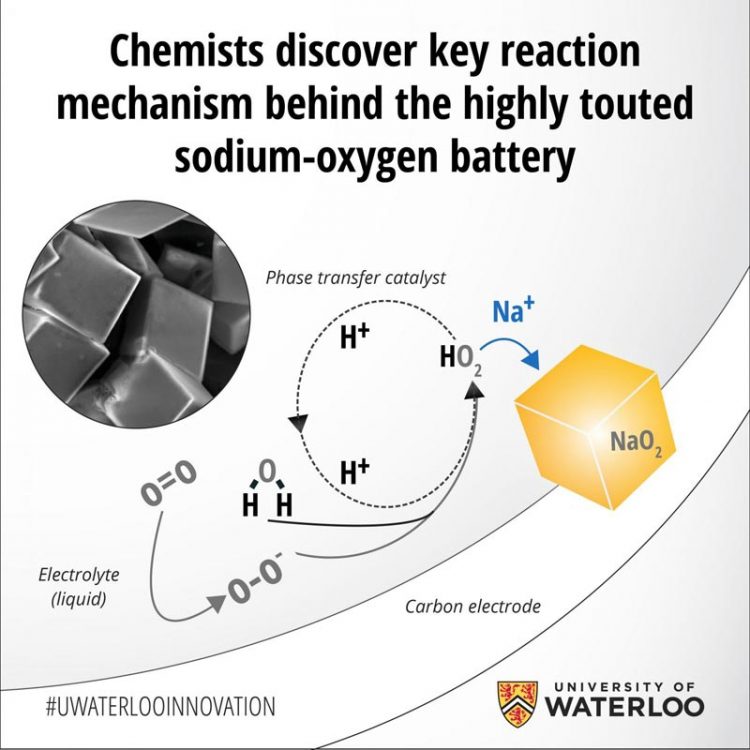Chemists discover key reaction mechanism behind the highly touted sodium-oxygen battery

Chemists at the University of Waterloo have discovered the key reaction that takes place in sodium-air batteries that could pave the way for development of the so-called holy grail of electrochemical energy storage. The key lies in Nazar's group discovery of the so-called proton phase transfer catalyst. By isolating its role in the battery's discharge and recharge reactions, Nazar and colleagues were not only able to boost the battery's capacity, they achieved a near-perfect recharge of the cell. When the researchers eliminated the catalyst from the system, they found the battery no longer worked. Unlike the traditional solid-state battery design, a metal-oxygen battery uses a gas cathode that takes oxygen and combines it with a metal such as sodium or lithium to form a metal oxide, storing electrons in the process. Applying an electric current reverses the reaction and reverts the metal to its original form. Credit: University of Waterloo
Researchers from the Waterloo Institute for Nanotechnology, led by Professor Linda Nazar who holds the Canada Research Chair in Solid State Energy Materials, have described a key mediation pathway that explains why sodium-oxygen batteries are more energy efficient compared with their lithium-oxygen counterparts.
Understanding how sodium-oxygen batteries work has implications for developing the more powerful lithium-oxygen battery, which is has been seen as the holy grail of electrochemical energy storage.
Their results appear in the journal Nature Chemistry.
“Our new understanding brings together a lot of different, disconnected bits of a puzzle that have allowed us to assemble the full picture,” says Nazar, a Chemistry professor in the Faculty of Science. “These findings will change the way we think about non-aqueous metal-oxygen batteries.”
Sodium-oxygen batteries are considered by many to be a particularly promising metal-oxygen battery combination. Although less energy dense than lithium-oxygen cells, they can be recharged with more than 93 per cent efficiency and are cheap enough for large-scale electrical grid storage.
The key lies in Nazar's group discovery of the so-called proton phase transfer catalyst. By isolating its role in the battery's discharge and recharge reactions, Nazar and colleagues were not only able to boost the battery's capacity, they achieved a near-perfect recharge of the cell. When the researchers eliminated the catalyst from the system, they found the battery no longer worked.
Unlike the traditional solid-state battery design, a metal-oxygen battery uses a gas cathode that takes oxygen and combines it with a metal such as sodium or lithium to form a metal oxide, storing electrons in the process. Applying an electric current reverses the reaction and reverts the metal to its original form.
In the case of the sodium-oxygen cell, the proton phase catalyst transfers the newly formed sodium superoxide (NaO2) entities to solution where they nucleate into well-defined nanocrystals to grow the discharge product as micron-sized cubes. The dimensions of the initially formed NaO2 are critical; theoretical calculations from a group at MIT has separately shown that NaO2 is energetically preferred over sodium peroxide, Na2O2 at the nanoscale. When the battery is recharged, these NaO2 cubes readily dissociate, with the reverse reaction facilitated once again by the proton phase catalyst.
Chemistry says that the proton phase catalyst could work similarly with lithium-oxygen. However, the lithium superoxide (LiO2) entities are too unstable and convert immediately to lithium peroxide (Li2O2). Once Li2O2 forms, the catalyst cannot facilitate the reverse reaction, as the forward and reverse reactions are no longer the same. So, in order to achieve progress on lithium-oxygen systems, researchers need to find an additional redox mediator to charge the cell efficiently.
“We are investigating redox mediators as well as exploring new opportunities for sodium-oxygen batteries that this research has inspired,” said Nazar.”Lithium-oxygen and sodium-oxygen batteries have a very promising future, but their development must take into account the role of how high capacity – and reversibility – can be scientifically achieved.”
###
Postdoctoral research associate Chun Xia along with doctoral students Robert Black, Russel Fernandes, and Brian Adams co-authored the paper.
The ecoENERGY Innovation Initiative program of Natural Resources Canada, and the Natural Sciences and Engineering Research Council (NSERC) of Canada funded the project.
Media Contact
All latest news from the category: Life Sciences and Chemistry
Articles and reports from the Life Sciences and chemistry area deal with applied and basic research into modern biology, chemistry and human medicine.
Valuable information can be found on a range of life sciences fields including bacteriology, biochemistry, bionics, bioinformatics, biophysics, biotechnology, genetics, geobotany, human biology, marine biology, microbiology, molecular biology, cellular biology, zoology, bioinorganic chemistry, microchemistry and environmental chemistry.
Newest articles

First-of-its-kind study uses remote sensing to monitor plastic debris in rivers and lakes
Remote sensing creates a cost-effective solution to monitoring plastic pollution. A first-of-its-kind study from researchers at the University of Minnesota Twin Cities shows how remote sensing can help monitor and…

Laser-based artificial neuron mimics nerve cell functions at lightning speed
With a processing speed a billion times faster than nature, chip-based laser neuron could help advance AI tasks such as pattern recognition and sequence prediction. Researchers have developed a laser-based…

Optimising the processing of plastic waste
Just one look in the yellow bin reveals a colourful jumble of different types of plastic. However, the purer and more uniform plastic waste is, the easier it is to…



